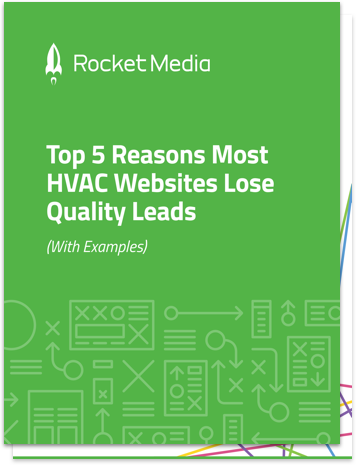Why Are My Competitors Outranking Me on Google?
on May 13, 2018
If your competitors are outranking you in search results, it’s most likely because you don’t have one or more of the following:
- Optimized local business listings
- Unique, quality website content
- Reputable backlinks
- A mobile-friendly website
- Website pages that load quickly
We’ll go over why each problem is important to fix.
Problem #1: Your local business listings aren’t optimized
When Google ranks sites in local search results, it looks at “citations”, that is, mentions of your home services business on other websites.
The impact of a citation source (where your citation comes from) can vary depending on the city or market, but outside of Google, we see the most impact from sources like:
- Yelp
- Bing
- Foursquare
- Superpages
- Apple Maps
Google and other search engines get local business information from these sources:
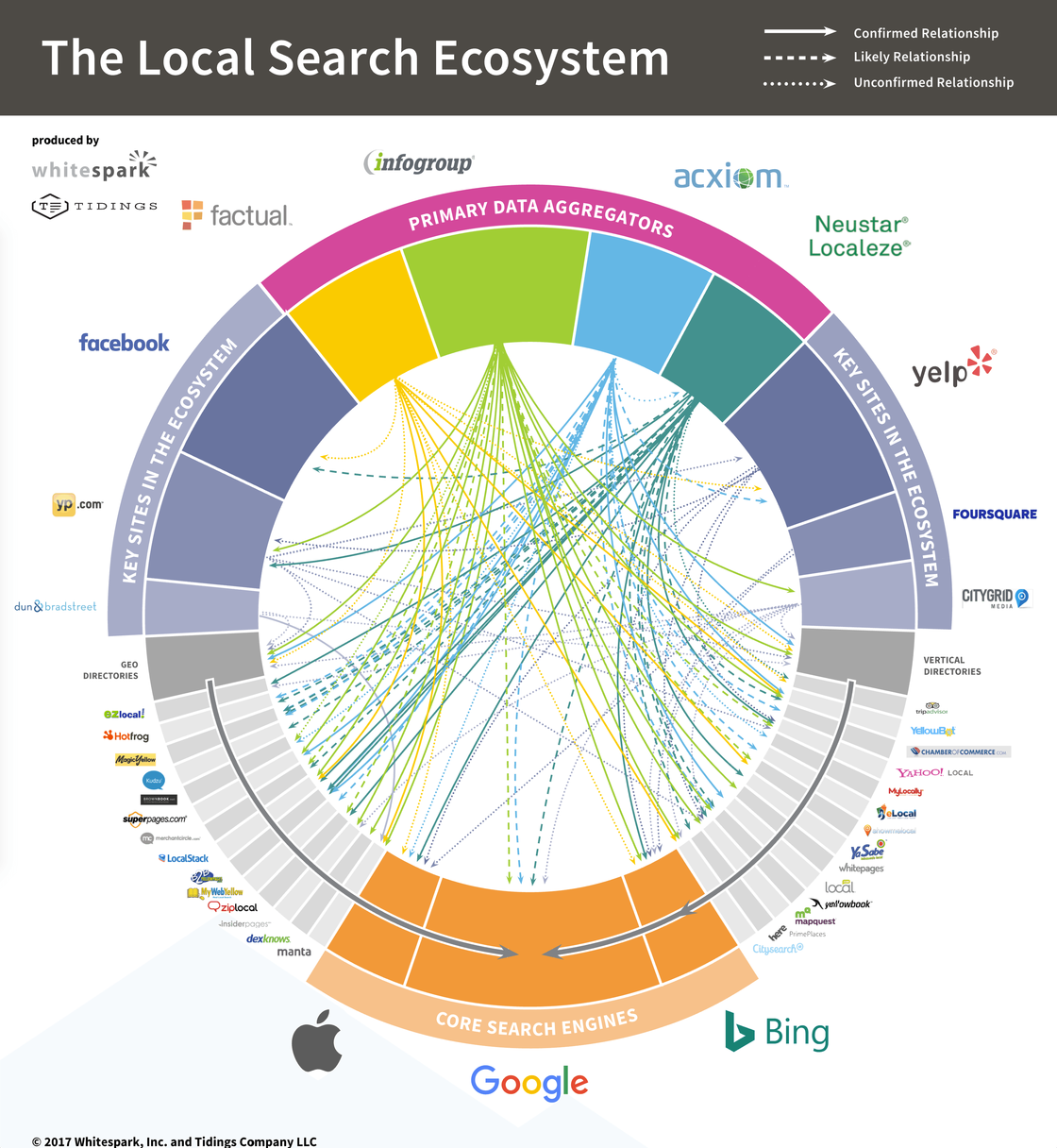
Source: Whitespark
Google looks at these citations to validate that your information is accurate. The more citations you have, the better your business looks to Google—and the more likely it is to rank.
If any of your business listings are inaccurate, outdated or not optimized for SEO, you’ll get lower rankings.
How to fix it
To optimize your home services business listings for SEO, make sure you:
- Claim your business. Most sites will require you to claim your business listing via phone or email. This is important, as verified listings are more trusted and more likely to rank well.
- Have consistent “NAP” (name, address, phone number) info. If Google notices the NAP info on your website is slightly different from how it’s listed on other sites, it could hurt your local ranking.
- Select service categories. Moz ranks “Incorrect Business Category” as the second most damaging factor for local SEO. Add primary and secondary categories that complete the statements “My business is…” or “My business does…” to improve rankings when users search for those categories.
- Add photos to your listing. This shows Google that your listing is accurate and up to date, making it more likely to list your business in a search query. Plus, it helps prospects get a sense of what your company is like.
- Tell customers how to find you on review sites. Reviews are becoming increasingly more important in local SEO rankings. Google looks at review content, how quickly you respond to reviews, and how many reviews you have. Google also looks at whether you respond to reviews, so be sure to do that.
Here are some examples of good home services business listings:
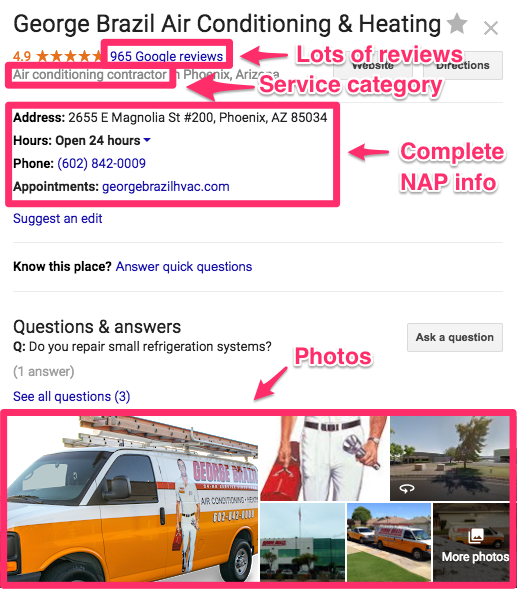
George Brazil Air Conditioning & Heating Google My Business listing
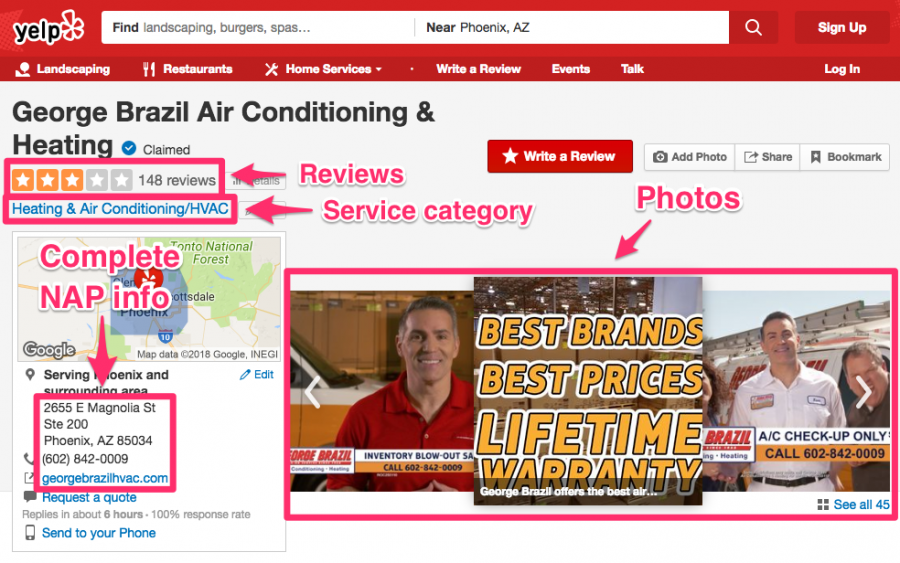
George Brazil Air Conditioning & Heating Yelp listing
To learn more about optimizing your business listing, check out our article, “Why Does My HVAC Business Not Appear in Local Search Results?”
Problem #2: You don’t have unique, quality content on your website
When it comes ranking well in search results, you need to have unique, quality content on your website.
Having a lot of duplicate content on your site can hurt your ratings, not to mention your traffic.
Here’s why: If Google sees more than one page with a lot of the same content, it won’t serve both pages in the search results (that wouldn’t be a good experience for the user). It will decide which page is most likely to be the best result, and serve that one, which negatively impacts rankings for the other pages.
For example, say you have an AC repair service page and AC installation service page with mostly the same content (similar headline, supporting content, brand promise, guarantees, etc.). Google could actually see these as competing pages and deliver the wrong page.
Duplicate content can happen maliciously (when content is deliberately copied to impact search rankings), but we don’t see that very often in the home services industry.
More often than not, home services sites have non-malicious duplicate content on things like:
- Brand promises/guarantees
- Service pages
- Maintenance plan pages
- Manufacturer product descriptions
Now, it’s okay to have some duplicate content.
You want to aim for about 60% unique content (more is always better). Once you get to 50% or less, you start seeing rank issues.
How to fix it
Check how much duplicate content is on your site using Siteliner. Just to give you an idea of how this site works, we tested it on Morris Jenkins’ site.
As you can see, their site has about 7% duplicate content, which is great for home services.
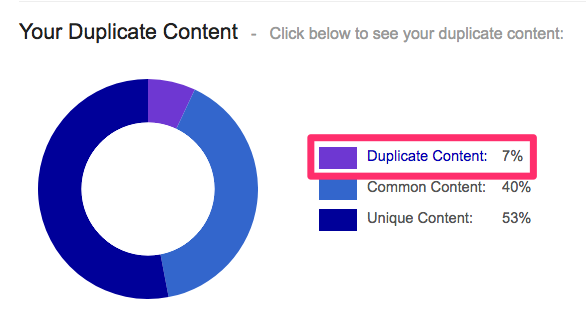
If you click on “Duplicate Content”, you’ll see all your pages that have duplicate content.
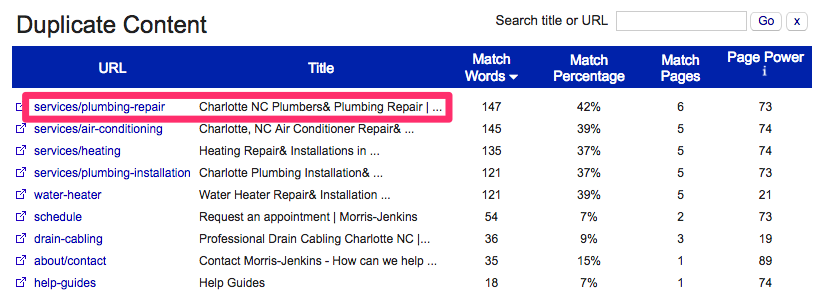
You can then click on each page to see exactly where duplicate content lives.

Duplicate content is color-coded to match other pages it’s found (on right).
If you see more than 50% duplicate content on pages, you can improve uniqueness by:
- Adding or removing content. Think about how you can make page content more unique. Can you condense or remove a guarantee? Add a customer testimonial? Localize the content?
- Combining and/or deleting pages. If you have multiple pages or blog posts that are similar, consider combining them into one. You’re more likely to rank higher with one high-quality page than several low-quality pages. Plus, this prevents what’s called “keyword cannibalization” (when multiple pages on your site compete with each other).
- Adding tags that tell Google to:
- Use a page as the “master”. By adding what’s called a “canonical tag”, you can tell Google that a URL acts as the master copy of a page, and is the one that should show up in search results.
- Not rank a page or section. By using what’s called a “No Index” tag, you can indicate that Google shouldn’t index a page or a section on a page, meaning it won’t deliver that page or section in search results.
- Permanently redirecting a page. By telling the “duplicate” page URL to go to the “master” page, the pages stop competing with each other and the “master” page has a better chance of ranking well.
Problem #3: You don’t have enough reputable backlinks
Backlinks are time-consuming to earn, but the boost they give your rankings is worth it.
A backlink is created when one website links to another. For example, if “Website 1” links to “Website 2”, “Website 2” now has a backlink.
Backlinks are essentially recommendations from one site to another. If search engines see a lot of sites linking to another site, they gather that site has valuable content, and is therefore worth delivering on search pages.
How to fix it
Just like anything else with SEO, quality is better than quantity.
You’re better off getting links from a dozen trustworthy, authoritative sites than hundreds of sketchy, low-authority ones. Links from low-authority sites damage your SEO ranking, and it takes a long time for your site to recover.
You can get reputable backlinks to your home services website by:
- Creating valuable content. The best backlinks are ones that are “natural” because you don’t have to ask for them. With editorial backlinks, other sites link to your content because it’s relevant and valuable, which tells Google your content is worth delivering in search results.
- Joining associations like the Better Business Bureau (BBB). This not only gives you a backlink to your website, but also shows customers that you’re licensed and insured.
- Asking to be listed on manufacturer/supplier websites. If you’re authorized to install certain products, ask to be listed on the manufacturer or supplier website.
- Joining your local Chamber of Commerce. You’ll likely have to pay to become a member, but it will give you a backlink to your site (from the membership directory) and show you’re involved in the community.
- Working with partners. If you have partners or friends in the industry, suggest listing each other on your sites.
- Listing your site on industry associations and trade sites, like the Air Conditioning Contractors of America (ACCA) or the Plumbing-Heating-Cooling Contractors Association (PHCCA). Most associations will have a membership directory that link to member sites.
- Sponsoring local teams, associations or schools. By adding quality links from these local sites, you’ll boost both your SEO and PR.
It also helps to be on social media sites (Facebook, Twitter, etc.) and review sites like Yelp, Facebook and Houzz. Some of their backlinks won’t directly influence your organic search ranking, but they do verify your NAP info, which helps boost your local search rankings.
Note: Google weighs social links differently, and can even index (label a page rankable) certain posts on some networks. Make sure you chat with an SEO expert to understand which platforms your customers use before running an SEO campaign.
Problem #4: Your home services website isn’t mobile-friendly
In 2017, Google started making the switch to “mobile-first” indexing. This means that Google first looks at the mobile version of your site (instead of the desktop version) to determine how you’re ranked.
If your site doesn’t have a mobile-friendly version, Google will crawl the desktop version, but the lack of a mobile-friendly site could result in lower rankings.
How to fix it
If you have a separate mobile website, make sure that the content is properly mapped and tagged to the corresponding desktop pages, or you could lose rankability long-term.
We recommend having a responsive home services website, so your site design adapts to any screen size and you eliminate the need for (and problems of) having a separate mobile site.
Make sure your site is truly responsive, though. Take a look at the website below. It’s technically responsive, but looks bad when you view it on a small screen because some elements don’t adapt as needed.
Bad responsive website
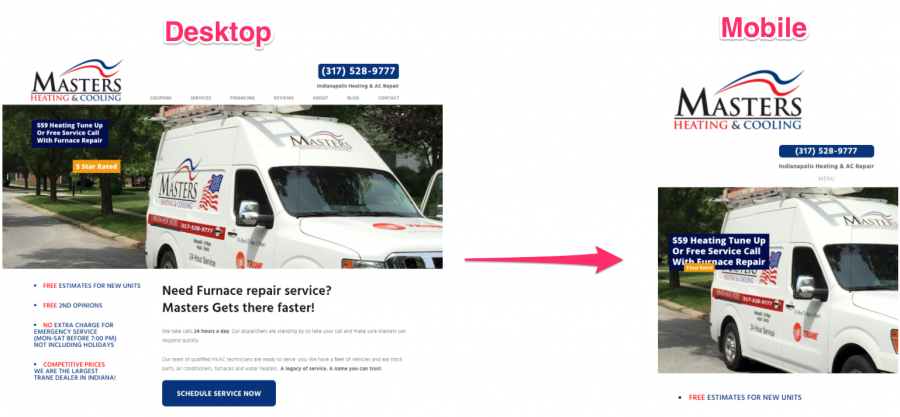
Screenshots of vanvaler.com taken on 4.10.18
Good designers and developers will know how to make a website that’s truly responsive and mobile-friendly.
For example, here are the desktop and mobile versions our team created for one of our clients:
Good responsive website
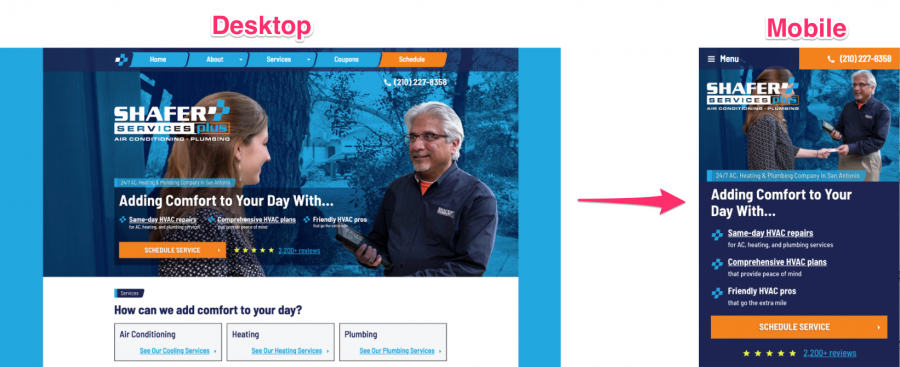
Screenshots of shaferservices.com taken on 4.10.18
Problem #5: Your home services website takes too long to load
“Page speed” refers to how long it takes to display all of the content on a page. Google takes site speed into account because they know a faster load speed creates a better experience for the user.
The longer your site takes to load, the more likely people will leave it. In fact, a study by Google found that 53% of people will leave a mobile site if it takes longer than 3 seconds to load.
What makes a site load slowly? It can get bogged down by:
- Improper or heavy coding
- Large images
- Too many URL redirects
- And other things
How to fix it
You can check your page load speed using Google’s PageSpeed Insights tool, which we tested on Morris Jenkins’ site:
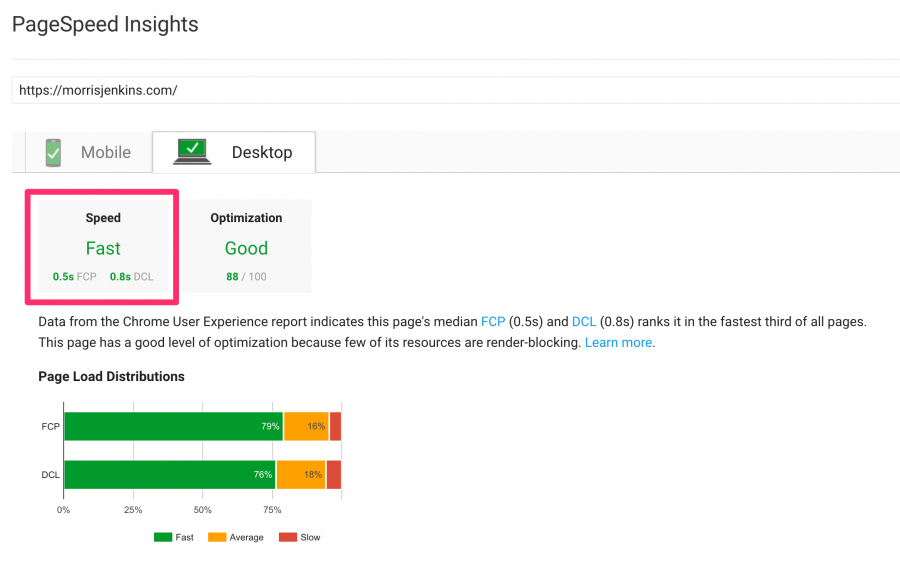
Desktop site speed of morrisjenkins.com on 4.10.18
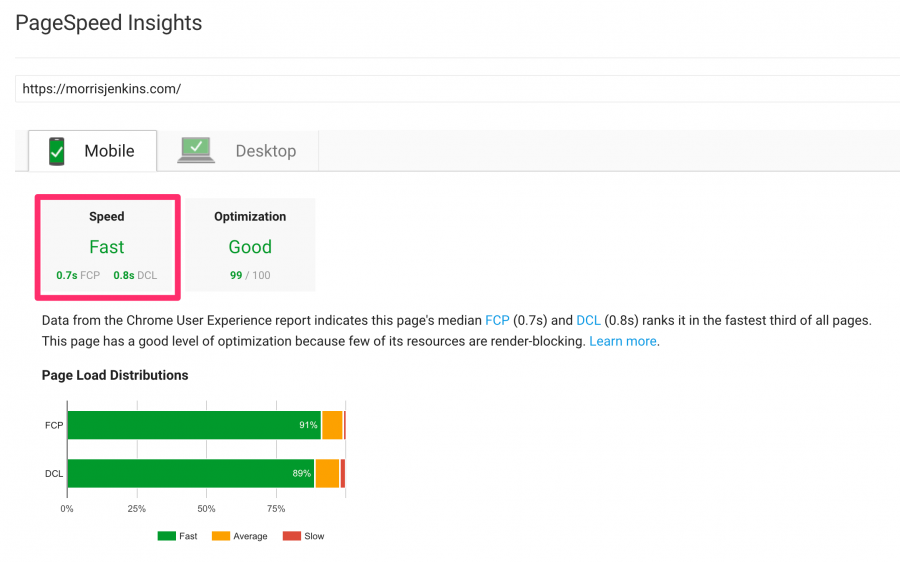
Mobile site speed of morrisjenkins.com on 4.10.18
If your site has slow load times (longer than 3 seconds), you can help improve speed (and SEO ranking) by:
- Cleaning up the code. You can dramatically increase page speed by removing unnecessary spaces and commas, code comments and formatting, and unused code.
- Optimizing images. Make sure images are no larger than they need to be, in the right file format (for web, SVGs are preferred over PNGs and JPGs) and ready to be used on the web.
- Reducing URL redirects. Each time a link redirects to another one, your user has to wait for the request to complete, which makes the page load slower. If too many exist, Google may give up on crawling your content and won’t rank it at all.
For more tips on how to improve site speed, check out Moz’s “Page Speed” help guide.
Need help outranking your home services competitors?
Since 2003, we’ve helped home services companies all over the country improve their rankings. Just drop us a line to chat with one of our SEO specialists.
Related Articles: HVAC SEO: How Quickly Can I Rank My Website? , Why Does My HVAC Business Not Appear in Local Search Results?

